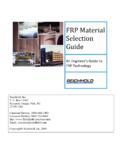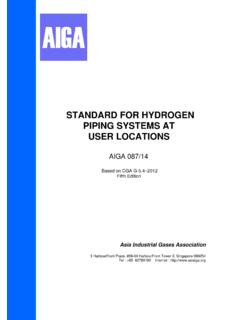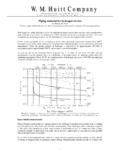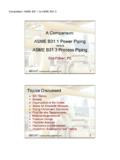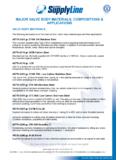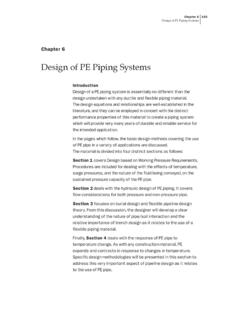Transcription of Defects Introduced into Metals During Fabrication and Service
1 UNESCO EOLSSSAMPLE CHAPTERSMATERIALS SCIENCE AND ENGINEERING Vol. III Defects Introduced into Metals During Fabrication and Service - and Neale Encyclopedia of Life Support Systems (EOLSS) Defects Introduced INTO Metals During Fabrication AND Service and Neale British Energy Ltd., Gloucester, UK Keywords: Defects , Metals , Service , failure, casting, cracks, forging, Fabrication , welding, metallurgical, heat-treatment, embrittlement, fatigue, creep, oxidation, wear, cavitation, tribosystem Contents 1. Introduction 2. Primary Production Defects Casting Defects Pipe and Shrinkage Inclusions Segregation Porosity Surface Defects Other Defects Forming Defects Cracks, Laps and Seams Surface Defects 3.
2 Defects Introduced During Fabrication Defects Resulting From Cutting Joining Methods Design Related Defects Procedure and Process Defects Metallurgical Factors Heat Treatment Stress relief of machined or welded components Hardening and quench cracking Embrittlement 4. Defects Introduced in Service Fatigue High Temperature Defects Mechanical property degradation and creep Environmental interaction Microstructural Changes Wear Abrasive Wear Adhesive Wear Fretting Erosion Rolling Contact Wear Embrittlement 5. The significance of Defects entering Service UNESCO EOLSSSAMPLE CHAPTERSMATERIALS SCIENCE AND ENGINEERING Vol. III Defects Introduced into Metals During Fabrication and Service - and Neale Encyclopedia of Life Support Systems (EOLSS) Glossary Bibliography Biographical Sketches Summary Defects may be produced During the processing, Fabrication and use of Metals in Service .
3 Those that are Introduced early in the processing chain may be carried forward to later stages where they can cause processing problems, or initiate failure. Some of these Defects result from complex metallurgical, chemical and physical reactions that Metals undergo During these processing operations and are difficult to avoid. They may also be inherent to the process. Whilst it is possible to minimize the effects of these reactions by applying knowledge about a materials behavior, good process and procedural control, it is preferable not to introduce problems that can be avoided by good practice. Defects Introduced During Fabrication may arise from either the carry over of Defects from earlier stages of processing resulting in the concentration of stresses, a reduction in the load bearing section of the product or changes in the metallurgical structure of the material so that it does not have the properties that the designer intended.
4 Some or all of these can cause the material to fail During Fabrication or enter Service with Defects present that may compromise integrity. Defects arising During Service may result from the presence of Defects or features Introduced During processing and Fabrication , the inadequate specification of materials, or operation outside the intended design criteria. 1. Introduction All Metals contain Defects . These can range from faults on an atomic scale that are inherent to crystallographic structures, to larger Defects that are Introduced During processing. These latter Defects may be avoidable, or at least reduced to a level whereby they pose no threat. The complex chemical and physical reactions that take place in the both the molten and solid state can produce effects resulting in both inhomogenities and Defects in the material .
5 Non-uniform properties can present problems During the processing, Fabrication and subsequent Service of metal components. Defects that are Introduced During the processing cycle will enter the Fabrication route and may cause further problems by either initiating a failure During Fabrication , or when the component enters Service . The misapplication of the manufacturing process or lack of control at any stage may introduce Defects and residual stress that can affect the performance of the structure in Service , making it susceptible to failure. Defects that may be produced include holes, cracks, segregation, inclusions, surface marks, notches and undesirable or unintentional metallurgical changes within the material .
6 Defects may be characterized not only by their origin, but also by their shape. Stresses are concentrated at notches, which occur at sudden changes in geometry. Very high concentrations of stress can develop at sharp notches. This is why planar Defects such as cracks, laminations, lack of fusion and lack of penetration type Defects are potentially UNESCO EOLSSSAMPLE CHAPTERSMATERIALS SCIENCE AND ENGINEERING Vol. III Defects Introduced into Metals During Fabrication and Service - and Neale Encyclopedia of Life Support Systems (EOLSS) serious. Three-dimensional (volumetric) Defects create a lesser notch effect, but can amplify stresses by reducing the load bearing area.
7 The following characteristics are some that are taken into account when assessing the significance of a defect: size sharpness orientation with respect to both the principle working stress and residual stress location with respect to the joints, the exterior surfaces and critical sections of the structure. 2. Primary Production Defects Defects may be Introduced when raw materials are made into a shape suitable for further processing. For convenience, the main defect types may be classified into the following broad descriptions. Those where the material has started out in the molten state: segregation, holes and porosity, shrinkage and piping , inclusions, shrinkage and hot tears and others where the metal is solid and is being processed further: cracks, surface Defects , residual stresses, embrittlement effects.
8 The following section describes the broad classification of Defects and describes their occurrence in specific processes. Casting Defects Pipe and Shrinkage When molten metal is poured into an ingot mold it cools, starts to solidify and contracts. The outer surfaces solidify first and become fixed, while the center remains molten and, as it in turn cools and contracts, a depression is formed in the top. If a source of molten metal is not maintained at the top of the ingot this depression can be quite deep. It is known as primary pipe. As the last of the ingot solidifies while isolated from any extra source of feeding, contraction cavities form at the core. This is known as secondary pipe.
9 Primary pipe is relatively easy to detect by eye and as it is exposed to the atmosphere it will oxidize and must be removed before further processing takes place. Secondary pipe, on the other hand remains hidden from view and although heavy forging may re-weld the cavities they may not be fully eradicated and remain in the UNESCO EOLSSSAMPLE CHAPTERSMATERIALS SCIENCE AND ENGINEERING Vol. III Defects Introduced into Metals During Fabrication and Service - and Neale Encyclopedia of Life Support Systems (EOLSS) finished product as areas of potential weakness. When casting into closed molds, it is important to allow for sufficient feeding to compensate for shrinkage During solidification.
10 In this respect, shrinkage in castings is similar to pipe in ingots. If insufficient molten metal is available to fill the cooling and contracting casting, shrinkage cavities may form. They are commonly found in the center of complex shapes and great thought has to be applied to the provision of an adequate system for continued feeding of molten metal. Another shrinkage related defect is the formation of hot tears. In this case the mold has fully filled prior to solidification, but contraction During cooling is in some way prevented by the geometry of the product. This occurs whilst the metal is still hot but has little strength. Tearing is often encountered at changes in section and where relatively thin sections join several large masses.










